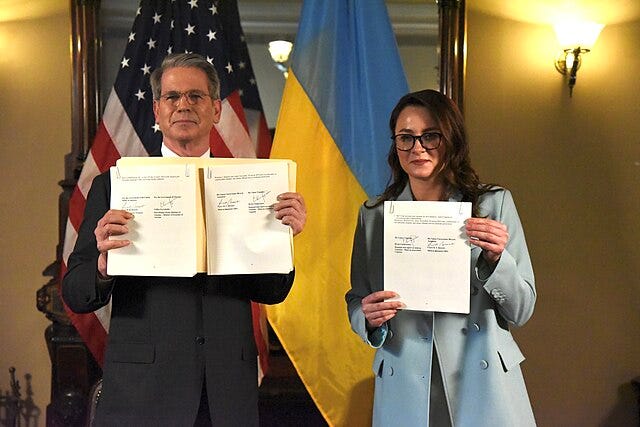The US-Ukraine “Minerals Deal” is Win-Win for Americans and Ukrainians
Treasury Secretary Scott Bessent and First Deputy Prime Minister Yulia Svyrydenko deserve genuine praise for negotiating an agreement that advances the interests of both countries.
When I first heard about the original idea for a “minerals deal” between Ukraine and the United States, I must admit that I was not a fan. It sounded like old-school colonial exploitation. What was especially appalling to me was that President Trump seemed to be taking advantage of a country desperate to secure financial benefits for the United States. Ukrainian officials had no choice but to engage in negotiations on this deal, recognizing that losing American support—particularly in military assistance and intelligence sharing— would severely undermine Ukraine’s war efforts against the Russian invading army. My fears about this deal only deepened after the disastrous meeting between President Trump and President Zelenskyy in the Oval Office on February 28, 2025, when the agreement was supposed to be signed. After that fiasco, I assumed the agreement would only get worse.
I was wrong. Behind closed doors, without cameras rolling as there were during the Oval Office meeting, Secretary Bessent, First Deputy Prime Minister Svyrydenko, and their teams calmly and constructively negotiated a final agreement that is favorable to both countries. On April 30, 2025, both Ukraine and the United States signed the “Agreement between the Government of Ukraine and the Government of the United States of America on the Establishment of a United States-Ukraine Reconstruction Investment Fund.”

As part of this deal, Ukraine and the United States established a joint investment fund for the reconstruction of Ukraine, which both countries will manage on an equal partnership basis. As in earlier versions, Ukraine will contribute 50 percent of its revenues from the new minerals, oil, and gas projects to the fund, but unlike before, it will retain full ownership over its “subsoil, infrastructure, and natural resources,” including decisions on what to extract. While this deal provides no credible security guarantees to Ukraine, it affirmed American “support for Ukraine’s security, prosperity, reconstruction, and integration into global economic frameworks.” Additionally, this deal states that “no state or person who financed or supplied the Russian war machine will be allowed to benefit from the reconstruction of Ukraine.”
Equally important is what is not in this agreement. Earlier reports indicated that President Trump insisted that profits from the minerals deal be used to repay the United States for the military and economic aid already provided. Thankfully, that formulation did not make it to the final version of the agreement. That, of course, is good for Ukraine, but it is also good for the United States. The earlier aid packages approved by the U.S. Congress and President Biden contained no such repayment provisions. Trump’s attempt to add them after the fact would have done serious damage to America’s reputation and made future agreements hard to negotiate with any country, not just Ukraine.
Of course, building the mines to extract these minerals takes years, if not decades. If it were easy, Ukrainian businesspeople would have done it already. As a CSIS report on this deal states, there are many barriers, including “outdated geological surveys, degraded energy infrastructure, and unresolved security risks.” Moreover, some of Ukraine’s most mineral-rich areas are believed to be in the eastern part of the country—a region currently occupied by Russian forces.
Another sad reality is that the signing of this deal has not altered the fundamental negotiating position of the Trump administration regarding the war. Trump and his team have promised Putin all sorts of concessions as a strategy to get him to sign a ceasefire, while simultaneously deploying coercive measures against Ukraine to compel Zelenskyy to sign a ceasefire. That strategy is not working, as I wrote a few weeks ago. (Read that essay here.) To date, Zelenskyy has agreed to a 30-day unconditional ceasefire, and Putin has not.

Nonetheless, the new agreement between Ukraine and the United States does seem to have propelled some renewed bilateral military cooperation. Last week, on the day the agreement was signed, the Trump administration approved a new disbursement of $50 million in weapons sales. Trump has not signaled any enthusiasm for proposing a new aid package for Ukraine, but at least he appears to be committed to finishing the provision of aid already approved during the Biden administration. Of particular importance to Zelenskyy, the Trump administration is also supporting the deployment of another Patriot missile defense system (to be provided by Israel, but overhauled by the United States). That’s progress.
And in the long run, American investors, entrepreneurs, and companies must be part of Ukraine’s reconstruction efforts. The “Agreement between the Government of Ukraine and the Government of the United States of America on the Establishment of a United States-Ukraine Reconstruction Investment Fund” is a positive step toward that win-win objective.




Thank you for explaining that to us.
I trust your expertise. Russia has to be defeated and the threat of endless war against the former Soviet Union democracies must end. Ukraine will emerge stronger.